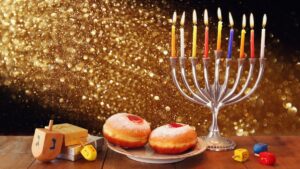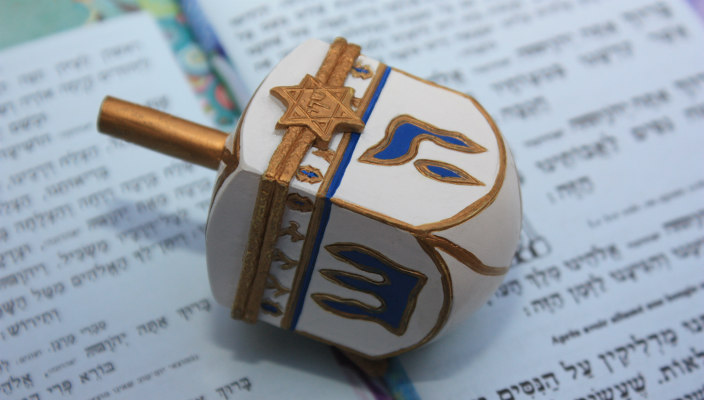Hanukkah, the eight-day Jewish festival of lights that begins this year on the evening of Thursday, Dec. 10, commemorates the rededication of the temple in Jerusalem that had been defiled after the Maccabean Revolt, a biblical story that celebrates the miracle of triumph against overwhelming odds. One part of the miracle, perhaps the part most familiar to today’s celebrants, is the story of how one night’s worth of oil miraculously lasted for eight.
Here’s a glimpse at what we do know about the holiday’s beloved modern-day rituals:
Candles
Though the candles might seem to be the most important part of any Hanukkah observance, the holiday’s original celebrants wouldn’t have used them. The tradition of using candles instead dates to 18th century Eastern Europe, when “candles became cleaner and cheaper, and people couldn’t get olive oil in the middle of the winter because it’s expensive. Most menorahs didn’t have branches before that time either, he says, until wealthy Germans started using them, and synagogues followed suit.
Latkes and Jelly Donuts
Speaking of oil, eating food fried during Hanukkah is considered a symbol of the oil used to light the menorah. Hence, jelly donuts. Known in Hebrew as sufganiyot.
Latkes (fried potato pancakes), probably the best-known example of traditional Hanukkah food, are also a relatively modern part of Hanukkah celebrations, at least as we know them today. The potatoes only became part of the recipe — and a big part of the Eastern European Jewish diet in general — in the mid-19th century.
Chocolate Gelt
These foil-wrapped chocolate coins you get may have evolved from a bunch of different traditions. One possibility is an 18th-century Eastern European tradition around Hanukkah, in which rabbis went from village to village giving Hebrew School-style lessons. They were rewarded by villagers with some kind of edible tokens of appreciation that may have included whiskey, grain, vegetables or honey.
Dreidel
The exact origins of this spinning top game are also unknown, but it’s thought to have derived from a 16th century game played in Ireland that made its way to Germany. As such, though the four letters on the four sides of the top are now said to stand for the words in the Hebrew sentence “a great miracle happened there”.
Let’s Take a Look at some Traditions around the World…
CUBA
In their cooking, Cubans use plantains in much the same way Americans and Canadians use potatoes: mashing them, baking them, and frying them. It should not come as a surprise, then, that Cuban Jews make fried plantains, otherwise known as tostones or patacones, for their Hanukkah celebrations.
SYRIA
The Jews of Aleppo were descendants of Sephardic Jews expelled from Spain in 1492. When they finally found a safe haven in Syria, they vowed to light an additional shamash (helper candle) on Hanukkah as a sign of thanks. This Hanukkah consider adopting the Syrian Jewish tradition of lighting an additional shamash in solidarity with the refugees who have fled Syria in search of shelter and peace.
FRANCE
In the wine-making region of Avignon in the south of France, it is customary to end the Shabbat that falls during Hanukkah by opening a new bottle or cask of wine.
After Havdalah, Jews would travel around the neighborhood to various homes, tasting the wines and toasting the holiday.
MEXICO
In Spanish, Hanukkah is known as Januca or Lucenarias – the feast of lights. Mexican children play a game called toma todo (winner takes all), which is similar to the version of dreidel that we play except the top has six sides instead of four. The toma toda dreidel is known as a pirinola. For a true multi-cultural experience, Mexican Jews often break a dreidel-shaped piñata filled with Hanukkah trinkets and treats.
ITALY
On Tishah B’Av, we read the Book of Lamentations, often in complete darkness. There is an Italian custom of saving the candle that was used to help us read on Tishah B’Av to help us light the menorah during Hanukkah. On Tishah B’Av, we mourn the destruction of the Holy Temple; on Hanukkah, we celebrate its rededication. Using the same candle for both occasions connects the two events: On Tishah B’Av we are sad, but on Hanukkah we rejoice as we rekindle this same light as the shamash for our festival of freedom.
KURDISTAN
Although Jews no longer live in Kurdistan, many Kurdish Jews still observe two unusual Hanukkah customs. The first is similar to the giving of Hanukkah gelt, but with a twist: a week before the holiday, children lock the doors to their rooms. Their parents must give them coins in order to gain entry.The second custom was developed by Jews too poor to afford a hanukkiyah. They used eggshells as cups for wicks and oil, lighting the required number of cracked shells every night.
MOROCCO
Jews in Morocco extended the joy of Hanukkah into a ninth day, which became known as “the day of the shamash.” On that day, children would go from house to house, collecting leftover Hanukkah candles. Then, they would make a giant bonfire, dancing and singing around it, and jumping and leaping over it. It was believed that jumping over the fire could bring good luck. Single women would jump over the fire in the hopes of getting married. Married women struggling to conceive would jump over the fire in the hopes of being blessed with a child.
TUNISIA
The seventh day of Hanukkah coincides with Rosh Chodesh Tevet, the beginning of the Hebrew month of Tevet, which has become a holiday within a holiday for Tunisian Jews.Known as Chag haBanot (Festival of the Daughters), girls and women celebrate the courageous act of Yehudit, the Jewish woman who saved the Jewish nation by killing the general sent by Antiochus, the evil ruler of the Syrian-Greek Empire.In celebration of the day, women would do no work, visit one another, and eat doughnuts and honey cookies. The holiday was particularly special for young women engaged to be married in the coming year.
Wishing you a Hanukkah that is filled with love, light, and the celebration of your own unique family customs!





